As a follow-up to my last post discussing who in the Quorum of the Fifteen would likely be Church President at some point, I made some figures that show Quorum members’ changing probabilities over time for the last 60 years. (A description of where these probabilities come from is in the previous post.)
A few notes about the figures:
- Each Quorum member’s line is labeled with as short a label as possible, which for most of them is just a last name. Where more than one member had the same last name, I’ve added only his first initial. Since the figures only cover 1950 – 2009, this means that “J. Smith” is Joseph Fielding Smith, not Joseph Smith, Jr. or Joseph F. Smith.
- Each Quorum member’s line is the same in color and style from one decade’s figure to the next. I hope this makes them easier to follow.
- Because the probabilities of becoming President are estimated based on only 1000 random number draws, the figures were initially quite jagged. I’ve smoothed the lines to make them easier to look at, which is why, for example, a new President’s line doesn’t jump immediately to 1 when his predecessor dies.
Okay, here are the figures. I don’t really have much to say about them. I made them because I thought they would be fun to look at and thought you all might enjoy them too.
Here’s the figure for 1950-1959:
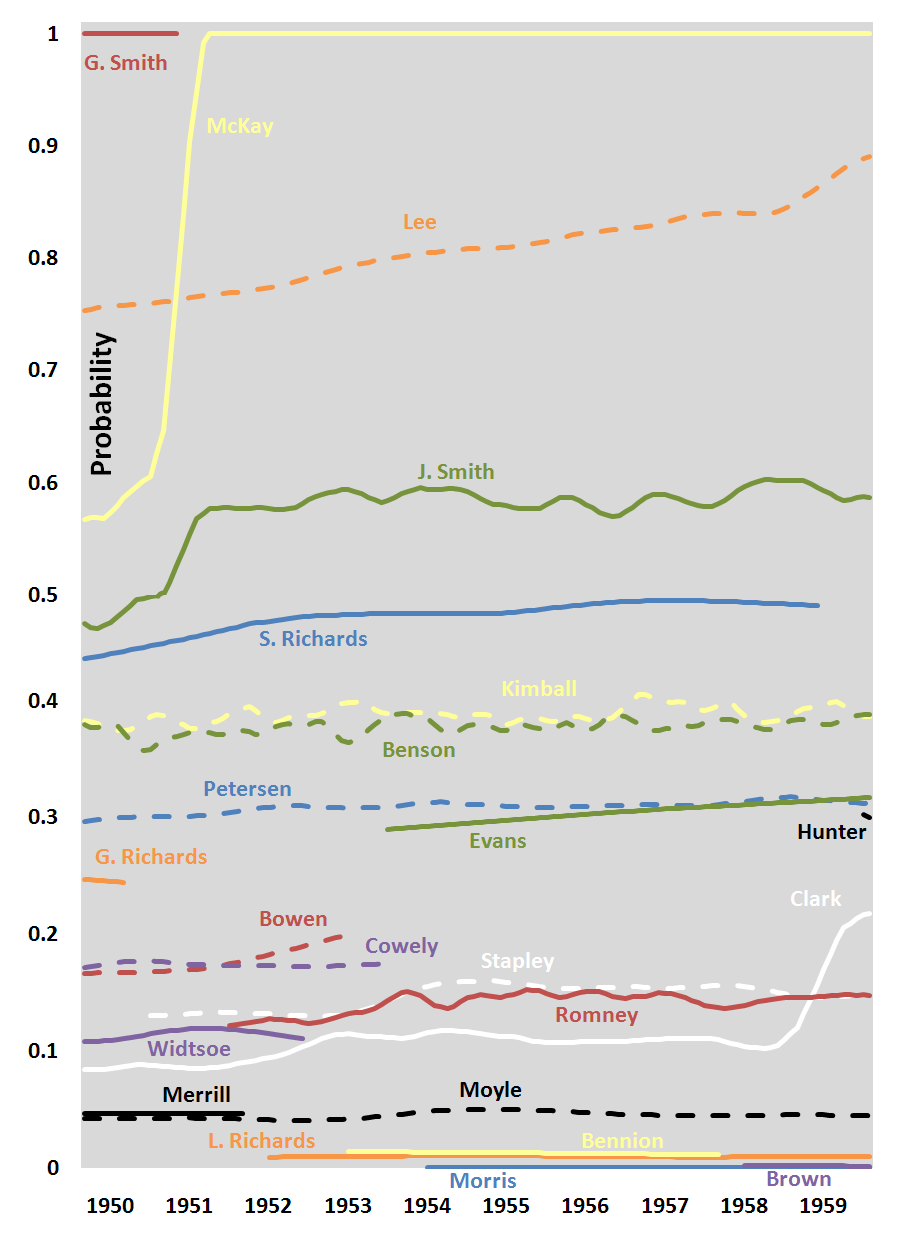
David O. McKay’s chances (yellow line) obviously got a big boost when George Albert Smith’s death elevated him to the presidency. But Joseph F. Smith (who moved from #3 to #2; green line) got a similar if smaller boost. I think I mentioned this in the previous post, but it’s interesting to see how this had no impact on, say Spencer W. Kimball or Ezra Taft Benson’s chances. They were far younger than President Smith, and extremely likely to outlive him anyway.
In the lower right part of the figure, you can see how J. Reuben Clark’s chances (white line) got a boost with the death of Stephen L. Richards, who was both younger than and senior to Elder Clark (actually President Clark–I think he was in the First Presidency at the time).
At the bottom, it’s apparent that people like LeGrand Richards, Adam S. Bennion, George Q. Morris, and Hugh B. Brown (sniff!) never had any real shot at becoming President.
Here’s the figure for 1960-1969:
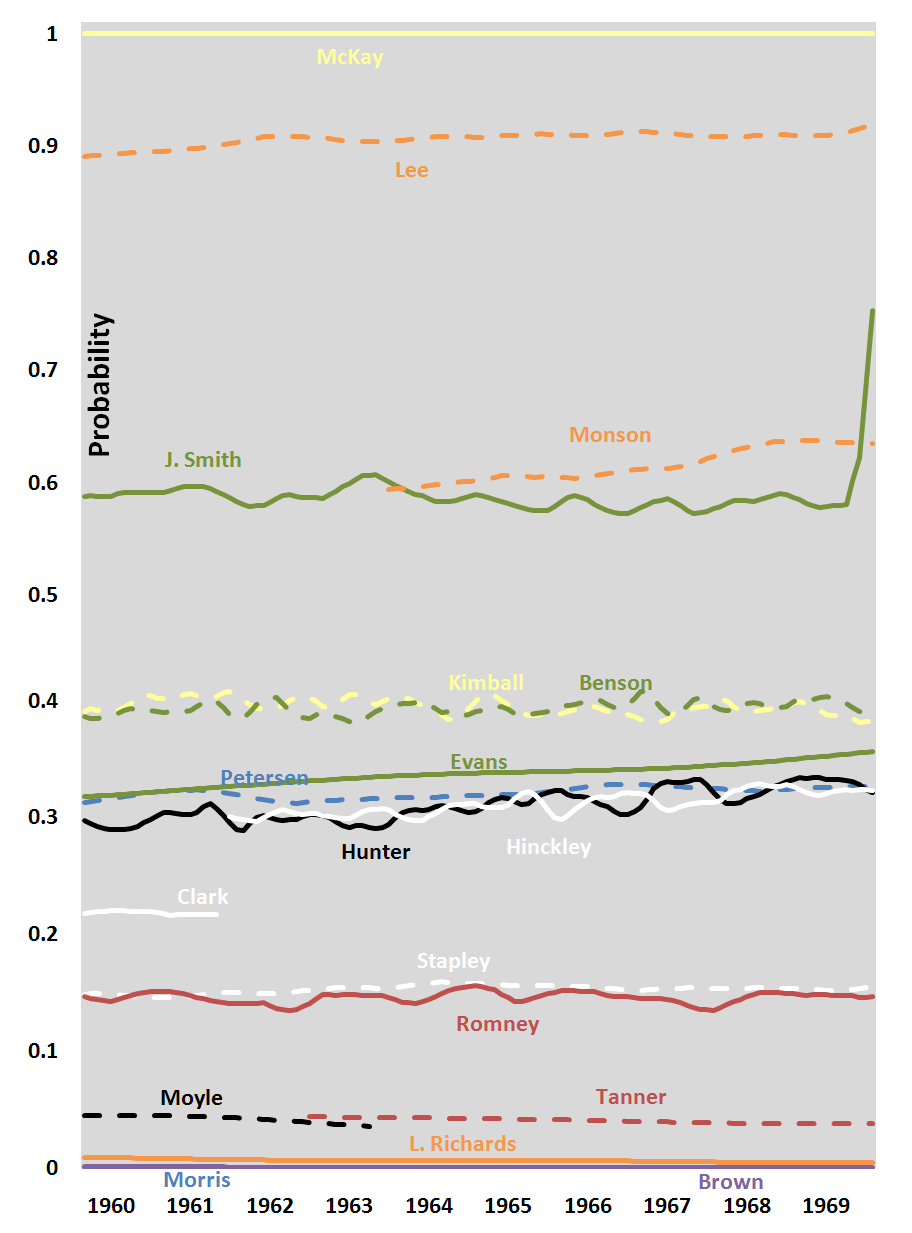
Everyone’s lines are pretty flat. When nobody much dies, nobody’s probabilities change much. You can see Thomas S. Monson (dashed orange line) entering in 1963 at an absurdly high probability.
Here’s the figure for 1970-1979:
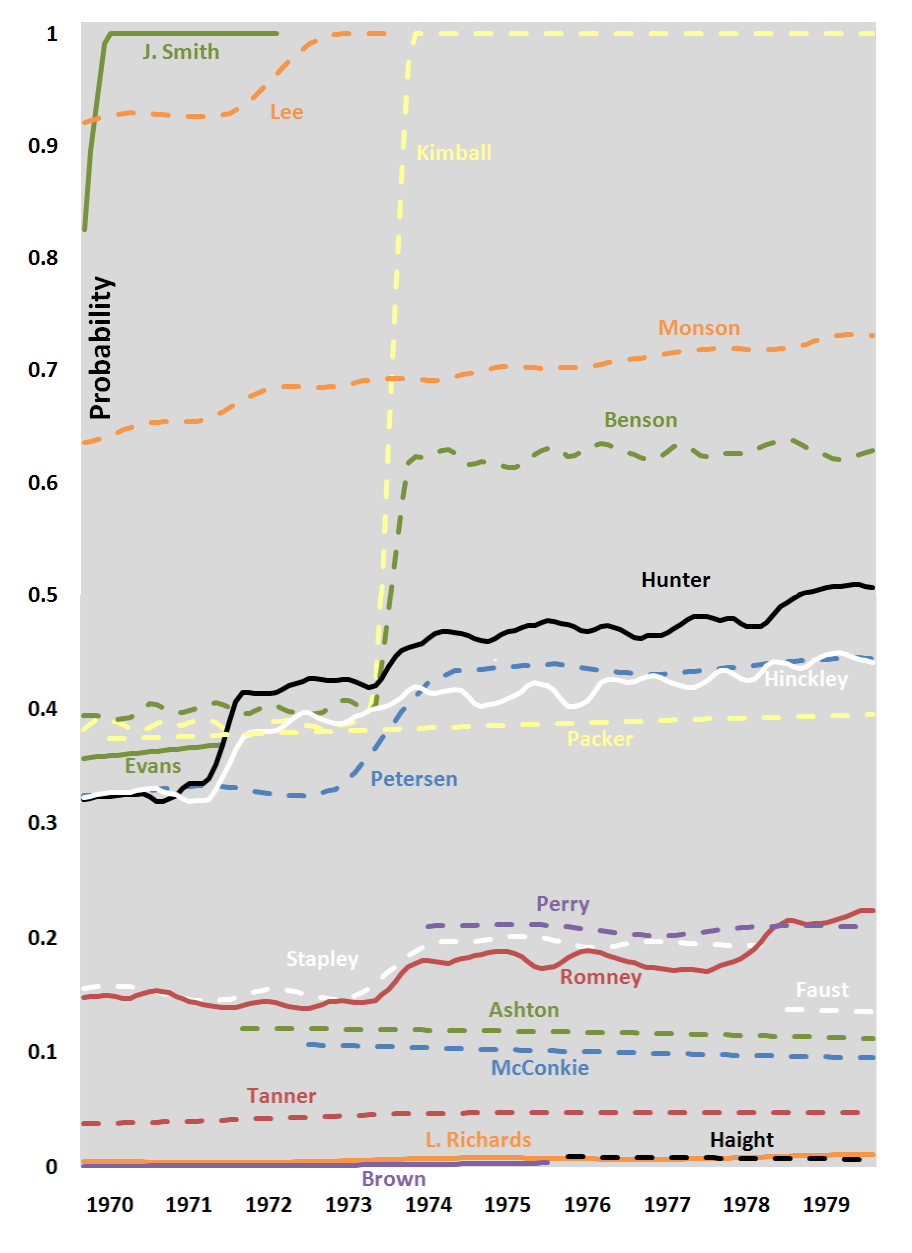 Now this was a decade with some action. President Lee’s early death (or maybe not so early given his family history, as BrianJ pointed out in the other thread) boosted Spencer W. Kimball (who was older than Lee; dashed yellow line) to the Presidency, but also notably increased probabilities for Ezra Taft Benson (dashed green line), Howard W. Hunter (black line), Mark E. Petersen (dashed blue line), Delbert L. Stapley (dashed white line), and Marion G. Romney (red line).
Now this was a decade with some action. President Lee’s early death (or maybe not so early given his family history, as BrianJ pointed out in the other thread) boosted Spencer W. Kimball (who was older than Lee; dashed yellow line) to the Presidency, but also notably increased probabilities for Ezra Taft Benson (dashed green line), Howard W. Hunter (black line), Mark E. Petersen (dashed blue line), Delbert L. Stapley (dashed white line), and Marion G. Romney (red line).
Earlier in the decade, lots of members moved up at the deaths of Joseph Fielding Smith, and perhaps surprisingly, Richard L. Evans (green line). Although he was only #9 in seniority when he died, Elder Evans’s death cleared the way for Howard W. Hunter (black line) and Gordon B. Hinckley (white line), as he was younger than and senior to both of them.
Here’s the figure for 1980-1989:
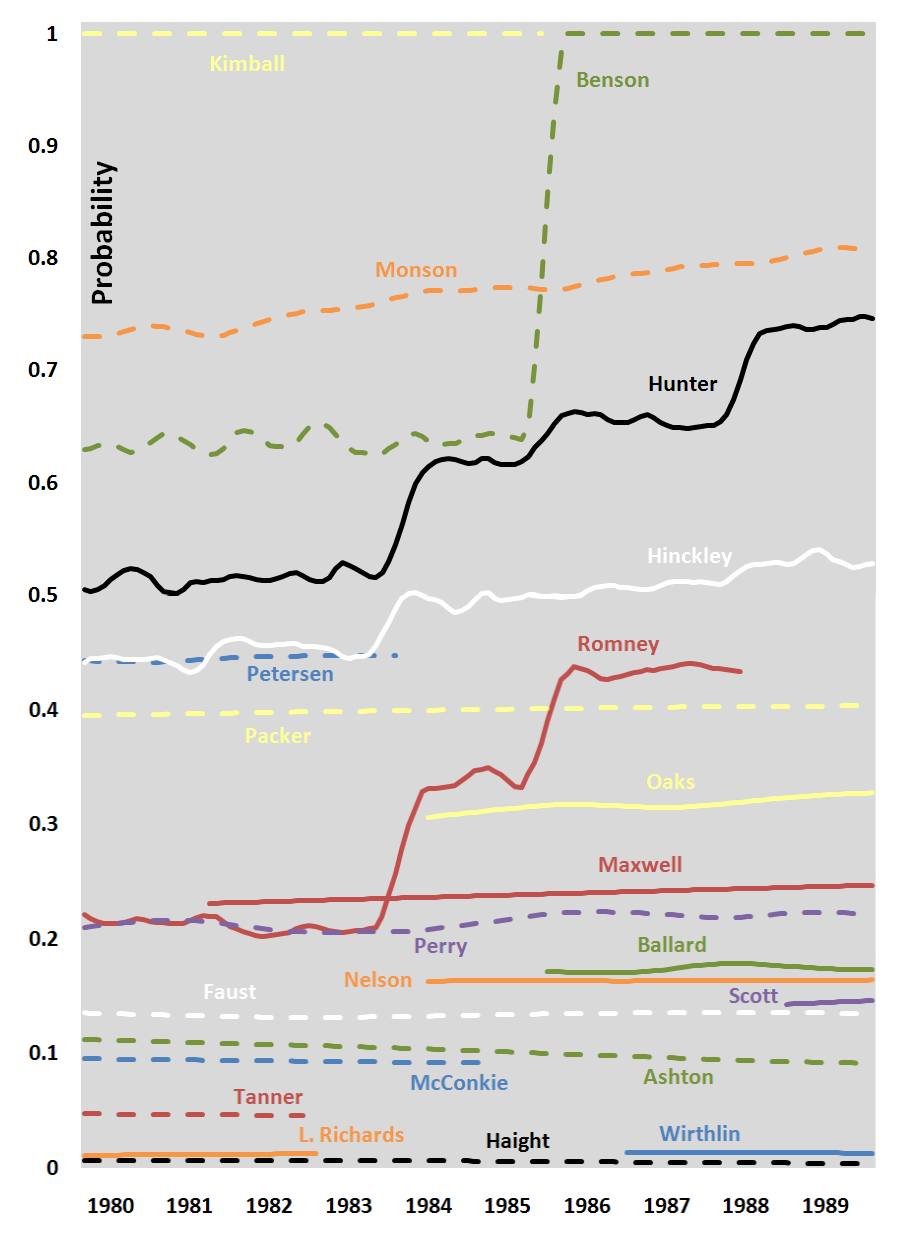
In this decade, Howard W. Hunter (black line) and Marion G. Romney (red line) saw their probabilities jump at the deaths of Mark E. Petersen (dashed blue line) and Spencer W. Kimball.
Here’s the figure for 1990-1999:
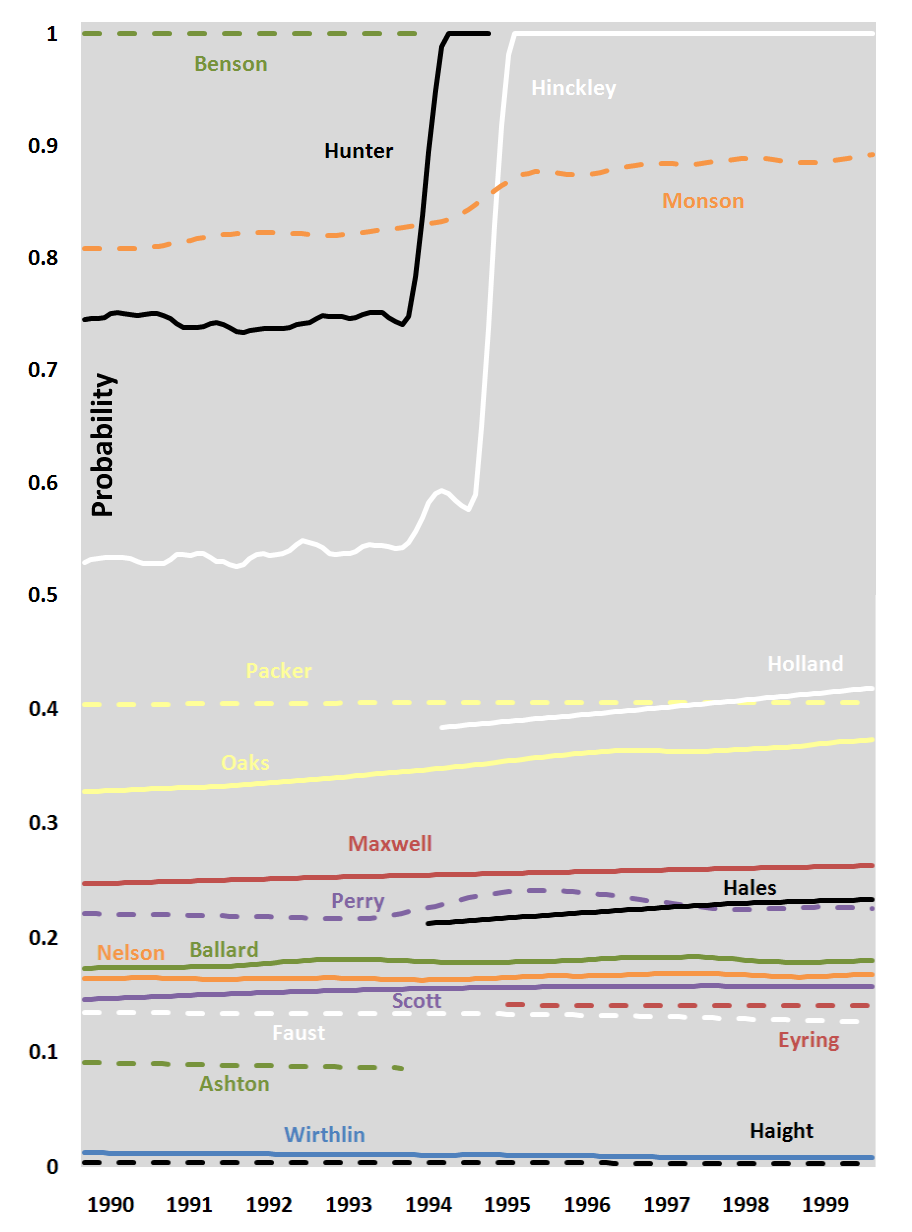
Ezra Taft Benson’s and Howard W. Hunter’s death’s made way for Gordon B. Hinckley to take over as President. But everyone else’s probabilities were pretty flat. They were far enough back in age that these deaths didn’t make a difference. Thomas S. Monson’s probability increased gradually, but again, these were men he was already very likely to outlive. And then of course in the latter half of the decade, nobody’s probabilities changed because nobody died.
Here’s the figure for 2000-2009 (only through September of this year):
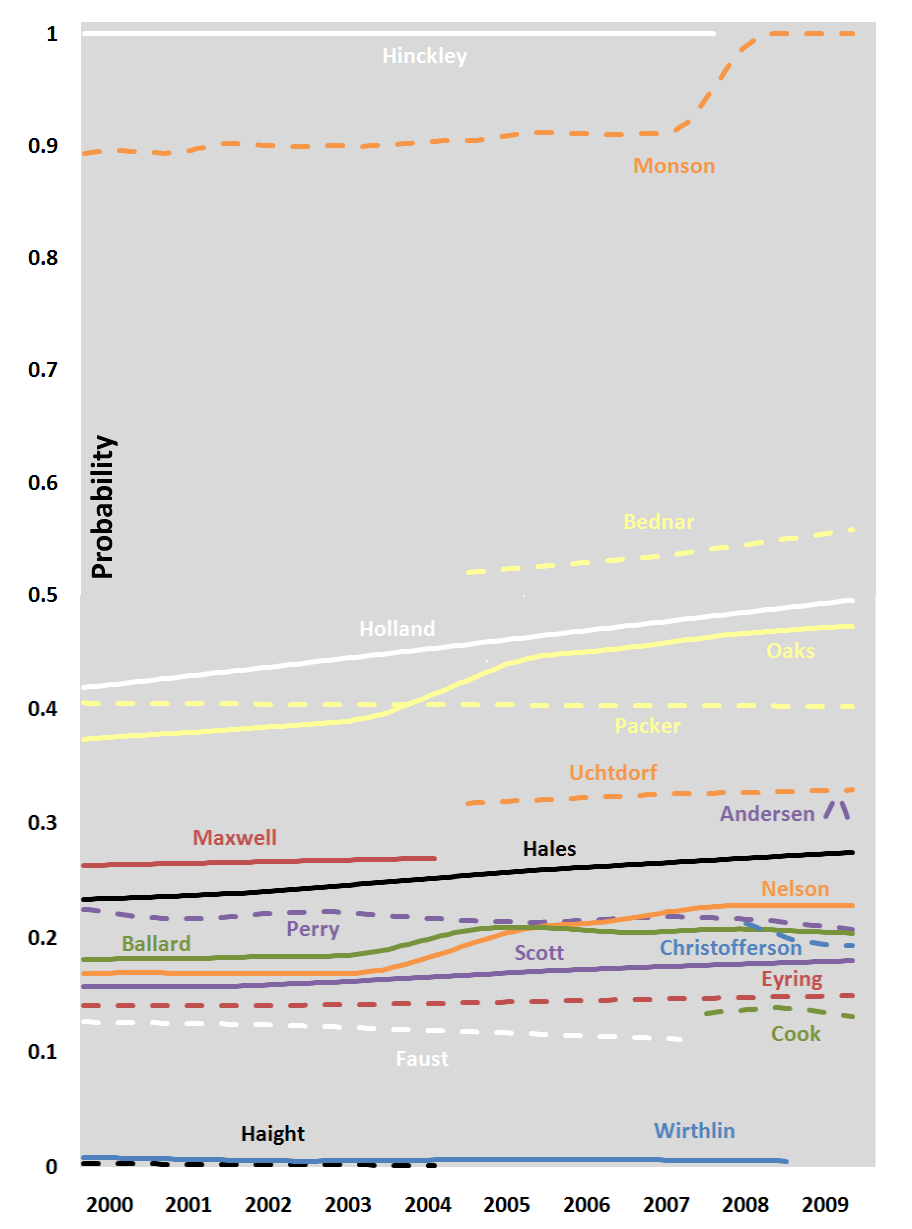
Again, there’s not a whole lot going on here. As I noted in the last post, David A. Bednar (dashed yellow line) entered much like Thomas S. Monson did 40 years before–with a very high probability of eventually becoming President given his age compared to the rest of the Quorum. And Jeffrey R. Holland (white line) and Dallin H. Oaks (yellow line) are also right there with him, their probabilities increasing gradually as passing time reduces older members’ life expectancies faster than it does theirs.
I’ll be interested to hear any observations you all have on these figures or on the topic of Quorum member longevity or succession more generally.
It’s kind of embarrassing to always just post worshipful praise in response to your work, so I have no comment.
It’s interesting that you should post this today, Ziff, as I just posted on Todd Robert Petersen’s novella “Family History” over at A Motley Vision.
What could that possibly have to do with this post? Well, the last third of the novella (which was published in 2007) engages in some speculative fiction through the 2013-2035 — and guess who he has as presidents of the Church during those years? Elder Oaks, then Elder Holland, then Elder Bednar. And in fact “President” Bednar’s counsel in 2035 to the members to write their family histories is the literary conceit behind the entire novella.
That’s pretty cool, William. I’m clearly far from the first person to notice that that group of three is likely to be President of the Church. It’s fun to hear of it being applied in the writing of fiction, though.
Thanks, E. And I’ll take all the praise I can get. 🙂 No, seriously, I figure my posting stuff like this isn’t like much of blogging that flows naturally into a conversation. It’s more just “here’s some random thing that I thought was fun and you might too.” So I understand that there’s not much to say about it.
.
Plus, “Family History” is awesome. Like your graphs. What do you use to make them?
Thanks, Th.! I typically just make them in Excel. This time I wanted to make them much taller than they are wide so that all the lines wouldn’t be on top of each other, so I made each one out of a pair of Excel graphs, which I exported to an image editor and stacked on top of each other.
Fantastic, Ziff.
(I’m not at all embarrassed to admit that I worship Ziff. When I grow up I want to be as brilliant and creative as he is.)
I’ve been struggling to understand some stats presented on another blog and still can’t follow them. You literally draw me a picture, and once I understand the general idea, your graphs are instantly comprehensible. What a gift!
Ziff:
This would be a bit more meaningful if you could weight your probabilities for a given time period for who will be the next president as opposed to who eventually will be the president.
Always fascinating, Ziff! Thank you for posting these.
I agree with Ardis (OK, I’m your sister, so I’m definitely biased, but still)–I think you have a real gift for making complex statistics comprehensible. Whenever I ask you statistical questions in person, you’re always infinitely patient and explain everything so clearly.
So cool.
Ziff, I also read your previous stats post and was so amazed. I love it!
Is it wrong to feel sorry for Elder Richards who was always hanging out on the bottom and never moving up? Always a bridesmaid and never a bride, sort of thing? I suppose I should also feel a little sorry for Elder Wirthlin but I just loved him so much, I don’t see any reason to 🙂
Very cool work! Thanks for doing it for those of us not smart enough to even think about attempting it!
Is it wrong to feel sorry for Elder Richards
Yes.
The repeated phenomena where the next president rises from a much lower probability of eventual presidency compared to Elder Monson to certainty when the current president dies seems to indicate something wrong with the probability calculations. That should typically only occur when someone dies an unusually early death.
President Kimball was pretty old when he died, was he not? If I were to guess, it has something to do with the difference between life expectancy at birth and life expectancy at age 80 or whatever.
On reconsideration, perhaps I am just discounting how much an outlier President Monson is. I am curious about the life expectancy at birth vs. life expectancy at age X issue though.
Mark D.:
The repeated phenomena where the next president rises from a much lower probability of eventual presidency compared to Elder Monson to certainty when the current president dies seems to indicate something wrong with the probability calculations. That should typically only occur when someone dies an unusually early death.
I think what this suggests is that in the usual circumstance, where the next-in-line member isn’t all that different in age from the President, it’s an open question as to whether the next-in-line member or the President will die first. This describes the transition from Harold B. Lee to Spencer W. Kimball (Kimball was 4 years older, and so according to the model, not likely to outlive Lee), Kimball to Benson (Benson was 4 years younger, but still not a sure bet to outlive Kimball), Benson to Hunter (Hunter was 8 years older), and Hunter to Hinckley (Hinckley was 2 and a half years younger). In these cases, the next-in-line member isn’t going to have a really high probability of being President because he may well die before the current President.
But, as you note, this does not describe the Joseph Fielding Smith to Harold B. Lee or the Gordon B. Hinckley to Thomas S. Monson transitions. This is because in these cases, the next-in-line member was far younger than the President, and therefore a virtual shoe-in to become President. Lee was 23 years younger than Smith, and Monson was 17 years younger than Hinckley.
There is lots to argue with in my study I’m sure, but I don’t think this pattern of changes in probabilities prior to a transition between Presidents is evidence of a problem.
Matt W.:
This would be a bit more meaningful if you could weight your probabilities for a given time period for who will be the next president as opposed to who eventually will be the president.
That’s a related question, but a separate one. I think it would actually be a less interesting question because there would be much less variability in the Quorum members’ probabilities. At any given time, only two or maybe three members have a realistic shot at being the next President. Sometimes it’s only one. During President Hinckley’s tenure, for example, it was quite unlikely that anyone but President Monson would succeed him. So a plot like the ones in this post for probabilities during that time period would show President Monson with his same slowly increasing probability, and all other Quorum members down near zero. And in general, plots showing such probabilities would typically show only a few Quorum members at a time with a probability appreciably different from zero.
One virtue of such plots is that at any given time, the sum of all Quorum members’ probabilities would have to be 1, which is of course not the case with the plots in this post. But still, I don’t think the small amount of added information is likely worth the effort.
Ben, Ardis, Eve, Ben and Enna, thanks for your kind words. I appreciate hearing that you find my numbers presentation easy to understand!
Why Elder Andersen’s weird trajectory – or is that just a glitch in the graph?
Good question, Ray. That happened because he’s been in the Quorum for so little time that the smoothing procedure had very little data to smooth. Before smoothing, most of the trajectories had lots of bumps like that.
Would it simplify things if we went back to seniority based on age rather than date of entry into the quorum as was done in the early days of the church? Would we still have bridesmaids?
Is there a statistical procedure whereby you could test your analysis by showing how predictive it was retroactively? In other words, based on the actual historical outcomes, how many apostles who became President had high probabilities in earlier time frames, and how many who had high probabilities in earlier time frames nonetheless did not become President?
Yes, JWL, there is. I mentioned it, but it’s buried at the end of my previous post (here’s a link). Briefly, the average error is 0.36, so men who did go on to become President had an average probability (averaging across their lives) of 0.64 (i.e., 1 – 0.36), and those who didn’t had an average probability of 0.36.
Mark D., if you’re interested in life expectancies at different ages, you might look at the US life tables that I used for 20th century life expectancies. I don’t know if this is what you were getting at, but as infant mortality has declined, a person’s life expectancy at any given age has moved closer and closer to their life expectancy at birth minus their age.
I love reading your graphs. Thanks for taking the time to make and share them.
I just want to add laurels to the growing pile. Ziff, these graphs are fantastic!
Thanks, Rachel and Tatiana! I really appreciate your kind words.
You know, it’s a shame I didn’t know you when I was taking my political statistics class! Love your charts, graphs, analysis, statistics and everything about your posts!! Good stuff!!!
What is the probability that a president of the church will be senile before he takes office? In the Q&A part of her lecture tonight, Jan Shipps said that Armand Mauss believes this will happen sometime.
Thanks, Brian!
And Rachel, I’m so jealous that you got to go hear Jan Shipps talk! Her (or Armand Mauss’s) point seems like a good one. I guess we’ve had the situation where the President has some difficulties after becoming President, and in that case the counselors have pretty much run things? (I’m thinking of Ezra Taft Benson, but wasn’t Heber J. Grant also not in really good shape for a while at the end of his tenure?) So with the tradition of counselors generally staying in the First Presidency from one President to the next, maybe in that situation the Quorum would just sustain the new President and then turn the Church over to the counselors who stayed on? I don’t know, though. It’s a good question.